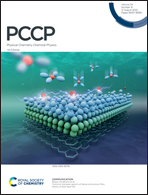Mechanism and kinetics of the reaction of the Criegee intermediate CH2OO with acetic acid studied using a step-scan Fourier-transform IR spectrometer†
Abstract
Acetic acid, CH3C(O)OH, plays an important role in the acidity of the troposphere. The reactions of Criegee intermediates with CH3C(O)OH have been proposed to be a potential source of secondary organic aerosol in the atmosphere. We investigated the detailed mechanism and kinetics of the reaction of the Criegee intermediate CH2OO with CH3C(O)OH. The time-resolved infrared absorption spectra of transient species produced upon irradiation at 308 nm of a flowing mixture of CH2I2/O2/CH3C(O)OH at 298 K were recorded using a step-scan Fourier-transform infrared spectrometer. The decrease in the intensity of the bands of CH2OO was accompanied by the appearance of bands near 886, 971, 1021, 1078, 1160, 1225, 1377, 1402, 1434, and 1777 cm−1, assigned to the absorption of hydroperoxymethyl acetate [CH3C(O)OCH2OOH, HPMA], the hydrogen-transferred adduct of CH2OO and CH3C(O)OH. Two types of conformers of HPMA, an open form and an intramolecularly hydrogen-bonded form, were identified. At a later reaction period, bands of the open-form HPMA became diminished, and new bands appeared at 930, 1045, 1200, 1378, 1792, and 1810 cm−1, assigned to formic acetic anhydride [CH3C(O)OC(O)H, FAA], a dehydrated product of HPMA. The intramolecularly hydrogen-bonded HPMA is more stable. From the temporal profiles of HPMA and FAA, we derived a rate coefficient k = (1.3 ± 0.3) × 10−10 cm3 molecule−1 s−1 for the reaction CH2OO + CH3C(O)OH to form HPMA and a rate coefficient k = 980 ± 40 s−1 for the dehydration of the open-form HPMA to form FAA. Theoretical calculations were performed to elucidate the CH2OO + CH3C(O)OH reaction pathway and to understand the distinct reactivity of these two forms of HPMA.

- This article is part of the themed collection: 2022 PCCP HOT Articles


 Please wait while we load your content...
Please wait while we load your content...